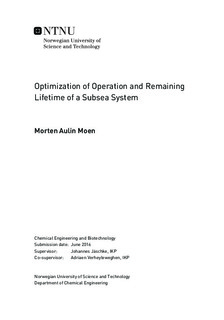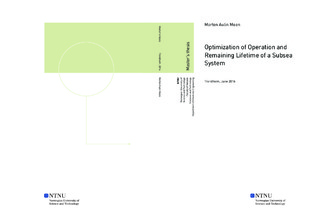| dc.description.abstract | A model of a subsea system was developed and optimization for operation and remaining life time. For the modelling of the remaining life time the compressor efficiency was used as there is no statistical or physical model available. Before the optimization was performed a degree of freedom analysis were executed, and it was found that 3 variables could be used for control. For the optimization four cases was examined. In the three first cases the objective function was changed. In the fourth case uncertainty was included and for handling the uncertainty chance-constraint was used. All of the calculation was done in Python 2.7 and the optimal control problem was formulated in CasADi 3.0. Optimization result from case 1 yielded 3 active constraint, these constraint was also active in all of the other cases. The lower bound the compressor efficiency which restricted the overall gas production. The upper bound on the mass fraction of gas in stream 3, which restricted the separation efficiency. The lower bound on the pressure in stream 6 was reached because of degeneration of the compressor efficiency. For case 2 the end time was included as a free variable. From the result of case 2 the upper bound on the end time was reached, as lower daily production of gas gave better separation. In case 3 the net present value of the gas was included in the objective function. In case 3 the optimizer found it advantageous to maximize the gas production in the beginning, which caused the time horizon to be reduced. For case four uncertainty in the reservoir flow coefficient was included for the optimization. For solving the optimal control problem with uncertainty chance-constraint was used. Chance-constraint was included on the lower bound on the compressor efficiency at the end of the time horizon and the upper bound on the mass fraction of gas in stream 3. The optimization result gave a higher probability of holding the constraint than the probability level. But calculating new back-offs and solving the optimal control problem again the probability of holding the constraint started to converge towards the probability level. With uncertainty in the optimization problem chance-constraint can be used. With chance-constraint the probability of constraint violation can be decided such that the back-off is reduced. | |

